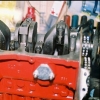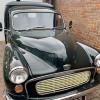I have followed relevant posts on TMF for wiring front spots and fogs and a few other items, however translating this to a shopping list is the tricky thing for me, particularly wiring. It would really help before I order if someone could comment that I’m heading in the right direction. I am wiring 3 Lucas 576 lamps each with a 48w LBL323 bulb (so approx.. 4amps each) and the other items – are the wire gauges (quoted in AWG) I have suggested appropriate?
- 1 x spot through the main beam 4 amps 16 gauge
- 2x fogs through dipped beam 8 amps 14 gauge
- 1 x reversing light through the remote gear switch 4 amps 16 gauge
- Voltmeter 16 gauge
- Cigar Lighter 12 amps (although as only for satnav etc will draw much less) 14 gauge
- Radio 3 amps 14 gauge to harness
- Panel lighting to additional gauges and illumination circuit for car radio 2 amps 18 gauge
My shopping list is
- 1 x 4-fuse blade-type fuse box
- 3 x 20 amp fuses (for fuse box)
- 3 x 12 amp fuses (for inline fuses to the light)
- 3 x 12V Relays – 30 or 40amp?
- Cable as above
- Heat shrink sheathing
I already have a crimper and selection of connectors
My queries are:
- Does the above list cover everything?
- Are my suggested gauge sizes correct?
- Should the supply from the solenoid to the fuse box be a smaller gauge, say 12?
- Is there a way of only attaching one cable from the solenoid to the fuse box, just to reduce the number of connections leading to the solenoid? If so, what size cable and presumably this can be fed to a junction box by the fuse box?
- Can I use the same cable size for earth throughout e.g. 14 or 16 gauge?
- Do the single Lucas 576 lights for the spot light and reversing light need to go through a relay?
- When cabling is sold and not described by AWG sizes, am I looking for ‘thin wall cable’? Some of the descriptions I’m afraid totally confuse me and different suppliers appear to have significantly conflicting details for something purporting to do the same job. For example, https://www.autoelec...70/category/114 states has12/0.20, 0.35mm², 7.0A - cable OD 1.4mm…for starters, what do 12, 0.20 and OD mean? This seems inconsistent with https://www.holden.c...er_metre_8/0.30, that says it is suitable for 8 amps but the area is quoted as 1.0mm². So which would be right for the 8am supply to the 2 fog lights?
- What size heat shrink cabling am I looking for?
I would appreciate any help! Many thanks in advance. If you would prefer a PM, then that’s fine by me. If you have had good experience with a particular supplier or any of the above product that would be great.
I hope everyone is having a Good Easter weekend.
Cheers
David
















